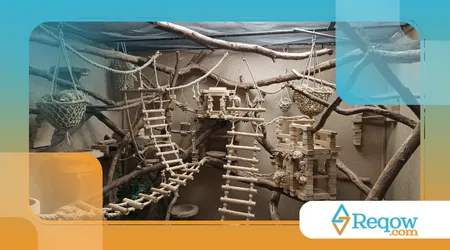Environmental enrichment routine with homemade items: stimulate your pet with creativity

Dogs and cats need much more than food, water, and a place to sleep. To stay mentally balanced and physically active, they depend on stimuli that challenge their senses and behavior.
Advertisements
THE environmental enrichment routine with homemade items It's one of the most effective, affordable, and caring ways to ensure this — without having to spend a lot or rely on ready-made toys.
Why does enriching the environment make such a difference?
Enriching your pet's environment means creating situations that stimulate their natural instincts. Dogs enjoy sniffing, exploring, and problem-solving.
Cats have an innate curiosity; they love to climb, hide, and hunt for toys. An environment lacking in stimulation can lead to apathy, stress, and even destructive behavior.
A study published in the journal Applied Animal Behavior Science showed that dogs subjected to enriched environments presented 33% fewer stressful behaviors than those living in spaces without stimuli.
Advertisements
This explains why even pets who receive all the veterinary care and affection in the world can still seem bored, anxious, or reactive. It's no exaggeration to say: without stimulation, they suffer—even indoors.
Read also: My dog wants to “mount” everything: sexual behavior, dominance or anxiety?
How to start an environmental enrichment routine with household items
You don't need to rush out and buy fancy toys. Most pets respond very well to simple, familiar objects, as long as they're used purposefully.
Cardboard tubes, empty bottles, pieces of cloth, boxes, jars with lids—all of these can become incredible toys and challenges for everyday life.
Before you begin, keep the basic rule in mind: safety first. No household items should have loose parts, sharp edges, or elements that could be accidentally swallowed.
Creating challenges with smell and scent
Environmental enrichment routines with homemade items can be especially fun when it comes to exploring animals' sense of smell. For dogs, a simple rolled-up towel with treats inside can be a challenge. For cats, scattering sachets in small boxes or hiding scented toys attracts attention and encourages hunting.
You can create a "smelling mat" with a piece of cloth and sewn strips, hiding treats between them. If sewing isn't your thing, use an old towel and fold it several times, placing small pieces of kibble between the folds.
Sensory stimuli with everyday objects
A cardboard box with small openings can be a great attraction. Place balls or treats inside and let your pet figure out how to reach the items. For cats, hanging ribbons, bells, or even paper balls tied with string in high places activates their hunting instinct.
Dogs can also be challenged with plastic bowls that move when trying to get a treat. This forces the animal to think and move more.
Alternation and unpredictability
The environmental enrichment routine with household items relies on something simple: variation. Moving objects around, hiding toys in different rooms, or setting up "circuits" around the house makes everything more interesting for your pet.
The secret is to create anticipation: what will I find today? This feeling keeps the animal mentally engaged and reduces behaviors like chewing furniture, digging, or incessant barking.
Cognitive stimulation with commands and rewards
Even with simple objects, it's possible to train your pet's brain. Hide a treat under three overturned cups and show your pet how to find the correct one. This activity works focus and memory. You can adapt this technique with different boxes, cloths, or containers.
If your pet already knows basic commands, use objects around the house to create obstacles and challenges: go under the chair, go around the cushion, sit on the rug and get a treat.
Integration with the feeding routine
Turning mealtime into a game is one of the easiest ways to create a rich routine. Swap the food bowl for a dispenser toy made from a plastic bottle, or fill a box with newspaper and scatter the grains inside.
Instead of giving everything at once, you turn the meal into something earned, which is much more natural for dogs and cats. This type of feeding activates the senses and even improves behavior.
Cats need vertical territories
Cats instinctively love heights. Stacked boxes, strategically placed shelves, and chairs near windows allow them to observe, listen, and rest from above. This behavior is ancestral and provides the animal with security.
A cat living in a flat environment, without access to heights, may show signs of frustration and even become aggressive toward people or other animals. Creatively adapting this space can make all the difference in their behavior and well-being.
Dogs need variations in tactile stimulation
For dogs, walking on different surfaces activates their muscles and brain. Carpets, artificial grass, wood, and even cloths spread on the floor create different sensations under their paws.
You can create a "sensory trail" at home with different textures. This activity is great for rainy days or when going outside isn't possible.
Interactive games strengthen bonds
A routine of environmental enrichment with homemade items is also an opportunity to strengthen the relationship between pet and owner. Many dogs and cats prefer interaction to the toy itself. Actively participating in play, even for five minutes, can be more effective than leaving objects available all day.
Have you ever tried playing hide-and-seek with your pet? Hide in another room and call your pet. This activity activates memory and smell, and strengthens the bond of trust.
The key is consistency (and fun)
The difference between a bored pet and a happy one can be found in the small details of their daily routine. There's no need to create complex activities or change the entire house. Just stay creative, adapt the environment safely, and observe what works best for your pet.
How many times have you seen your pet play with the gift wrapping and ignore the toy? This shows that simplicity, when applied well, is powerful.
Conclusion: enriching the environment is an act of love
Implementing an environmental enrichment routine with homemade items is a direct way to demonstrate care and empathy for your pet. It goes beyond just fun. It's about promoting mental health, preventing behavioral problems, and creating an environment where your pet can express their instincts freely and safely.
You can do a lot with a little, as long as you're intentional. A roll of paper, a box, and some snacks can transform your partner's day. And when they look at you after such an activity, it's as if to say, "Thank you for understanding."
Frequently Asked Questions About Homemade Environmental Enrichment
Is it safe to use recyclable objects with pets?
Yes, as long as they are inspected first. Avoid sharp edges, loose parts, or objects that could be swallowed. Always supervise.
How many times a week should I vary the stimuli?
Ideally, you should introduce something new or change the arrangement of objects at least three times a week. Variety is what keeps things interesting.
Do puppies need enrichment too?
Yes! It's even essential for their mental and behavioral development. But activities should be adapted to their age and size.
Do older pets benefit from these practices?
A lot. Cognitive and physical stimulation helps keep the mind active and slows the progression of age-related problems.
Is there a risk of the pet becoming dependent on games?
No. On the contrary, enrichment reduces anxiety, promotes autonomy, and makes the animal more balanced in all daily routines.
